From Habitat magazine - issue 13
Robyn Kilty blames the stars for her predilection for bright red doors and flowers.
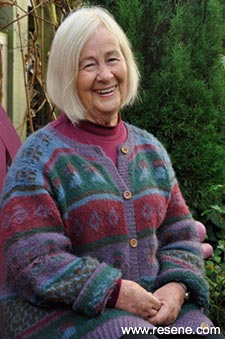
Robyn Kilty is planning her next outrageous colour scheme.
If you are born under the star sign Taurus, chances are you are going to be a colour freak. Taureans have a predeliction towards colour. I was born a Taurus and I can't help myself.
It makes sense, therefore, that the first time I saw the Victorian workers cottage which I was later to buy, I saw it in terms of what could be done with it in colour. The practical repairs were the necessary and expensive part of the restoration, but also the tedious part. Colour was the real deal!
Even so, the first painting of the cottage was reasonably conservative as I felt confined by the highly pitched and quite dominant new blue-grey COLORSTEEL® roof, so I used a putty colour, Resene Thistle, on the weatherboards and dark blue around the doors and trims.
Despite this tasteful beginning, I couldn't resist breaking out somewhere, so the front door was painted bright Resene Guardsman Red. It was this red which was the inspiration for the garden. That, and a recent visit to Monet's garden at Giverny in France.
During the early 1990s, it was fashionable to use pastel colours in the garden, influenced by Vita Sackville West and Sissinghurst's White Garden. Nobody in New Zealand seemed to have heard of Vita's Hot Garden at that time so reds and oranges were perceived as the worst of taste. As for magenta – don't even mention it!
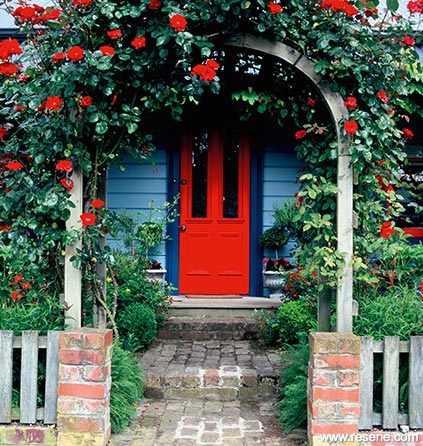
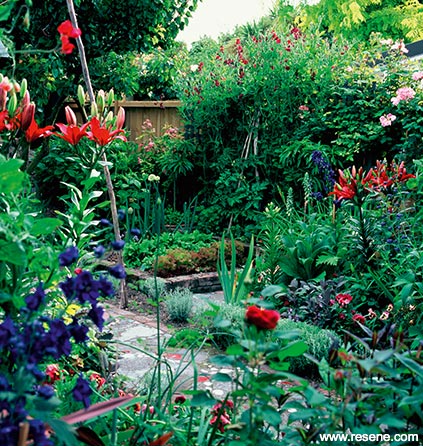
After seeing Monet's garden in late summer, and the jewel-like way the magentas of dark cosmos, dahlias and gladiolia were interspersed with the rich golds of rudbeckia, sunflowers and golden rod, I knew there would be no more pastel for me.
I couldn't wait to get home and plant those tasteless red flowers in my front garden to complement the Resene Guardsman Red door. At first I experimented with all the reds together – the cool magentas and crimsons, as well as the hot scarlet reds and terracotta – but found that in my small front garden, this just didn't work. It looked too spotty with no impact. I have seen since the cool and hot reds planted together in large gardens where there is plenty of space for each species and colour to be planted en masse, each making it's own statement interspersed with foliage, and it looked stunning.
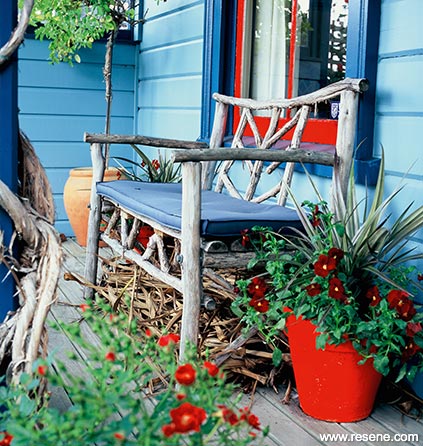
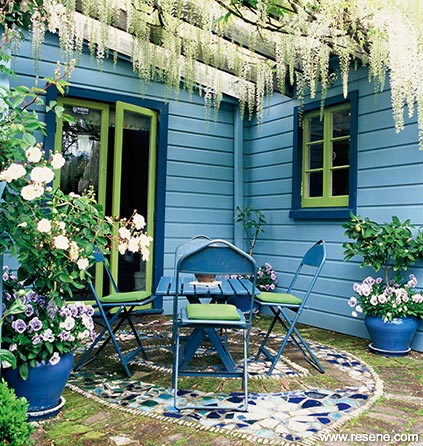
In a small space, however, less is more, so I began to limit my palette, using only the hot scarlet reds, such as Geum 'Mrs Bradshaw' and terracotta reds such as the brownish-red rose 'Colourbreak'. These are planted with bronze foliage plants such as flax and heuchera 'Amethyst' and also with lime green Helleborus corsica and Euphorbia polychroma. Amongst these plantings are splashes of rich dark blue – sometimes delphiniums, sometimes the perennial forget-me-not Omphalodes cappadocica which echoes the blue painted trims of the house.
I fiddled with colour in the garden for a number of years until it was time to paint the house again. I resolved to be brave and a little outrageous this time, so I painted the weatherboards quite an intense mid-blue called Resene Bermuda Grey which blended well with the denim grey roof, and I used a brighter dark blue (Resene Madison) on the architraves and veranda posts. I also used more of the wonderful Resene Guardsman Red, not just on the front door, but also on the insides of the window trims and on terracotta pots for the veranda.
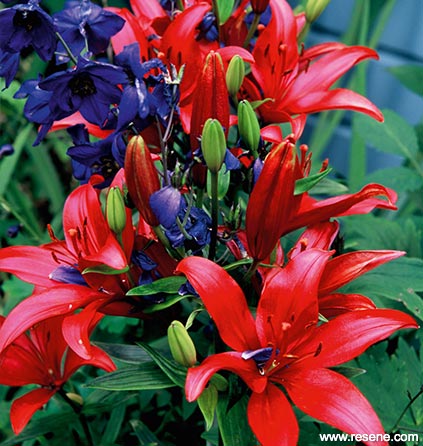
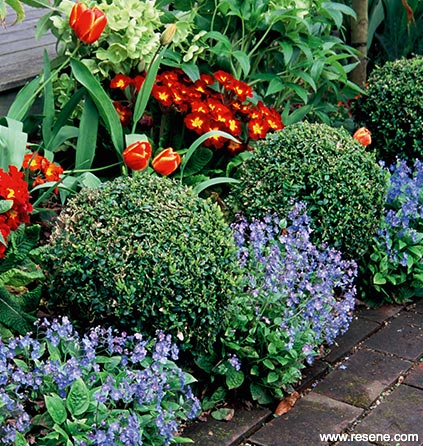
This was fine for the front garden where scarlet was king, but I didn't want to be confined to scarlet flowers in the side and back gardens as well, so I changed the colour of the trims and doors beyond my side fence, using lime green Resene Wasabi which also looks great with blue.
This freed me up with my colour choices in the side and back gardens, as almost any colour will look good with blue and lime green. Here, I indulged in the wonderful cool reds – the magentas, burgundys and even hot pinks which I also love. To these I have added purple, and even pale pink and touches of white. Again, I have used purplish/bronze foliage, as well as more blue flowers – blue is the most flexible colour in the garden offsetting almost any other colour. These cool red and pink tones do blend well against the blue of the house at the back and the lime green of the doors complements all.
The house will soon be in need of painting again, so where to next? In my head I have already worked out a colour scheme which will change everything… and it will not be demure.
Plant types: Climbing rose ‘Nancy Hayward‘. Crimson asiatic lilies and dark blue delphiniums. Buxus with perennial forget-me-not (Omphalodes Cappadocica).
a farm-inspired scheme transforms this courtyard
Wendy Twine, of Twine Landscape Design, suggests this alternative scheme:
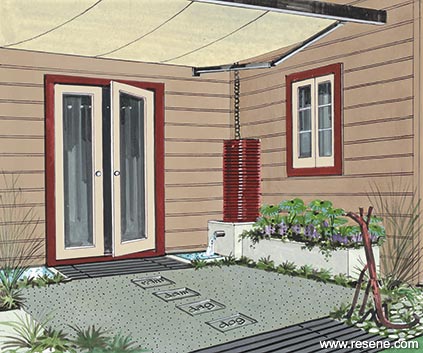
This whimsical design is inspired by the farming landscape with a natural colour palette enhanced by modern interpretations of iconic rural features. An exposed aggregate courtyard is accessed via wooden 'cattlestops' traversing a water feature and a dry river bed of pebbles. This dichotomy emphasises the water conservation message, reflected in the chain downpipe and corrugated iron water tank. The cattlestops are linked by pavers inscribed with key rural words. The image of farm water troughs is evoked through raised concrete planters, embellished with grasses and rushes or quirkily named plants such as Ligularia 'Tractor Seat' and Lambs Ear. Barry Lett's dog sculpture sits patiently, awaiting his master and his day's work to begin. And at the end of the day there is a collapsible wooden bar table (not shown) with tractor seat bar stools reminiscent of old woolshed tables. A retractable awning creates shade in hot summers.
A rural twist with weatherboards in Resene Cargo and trims in Resene Dynamite and Resene Spanish White. The wooden 'cattlestops' are stained in Resene Crowshead.
mobile: 027 226 4584 email: wendy@twinelandscapes.co.nz
Accessories: Lambs Ear (Stachys lanata). The Guardian sculptureby Barry Lett. Mediterranean retractable awning, from Weathermaster. Water tank, from Tanks Alot. Ligularia 'Tractor Seat'.
a calm, uncluttered solution for this courtyard
Jennifer O'Neill-Joyce, of Gardens 2 Go, suggests this alternative scheme:
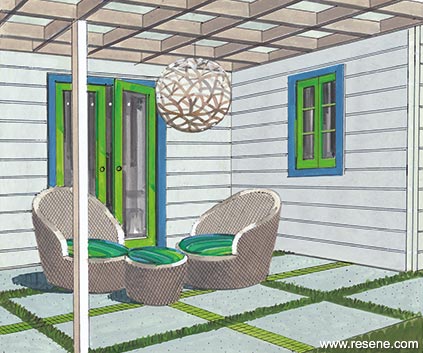
This is a contemporary space which offers an uncluttered and easy-care area to relax in. The lime and blue colours (Resene Limerick and Resene Venice Blue) of the window joinery are echoed throughout the space in the squab fabric and mosaic tiles set into the coloured and cut concrete. Green mondo grass softens the concrete, the grid pattern of which provides visual interest. The open cedar pergola, finished in Resene Limed Oak (stain finish), mimics the grid pattern below, allows for natural light and defines the space as an 'outdoor room'. Extending the pergola and ground plane grids past the lines of the house gives the sense of more space. The pendant light acts as a sculptural piece during the day, and makes the area highly usable at night. The setting is finished off with welcoming and comfortable chairs.
This contemporary yet summery scheme uses weatherboards in Resene Foggy Grey with trims in Resene Limerick and Resene Venice Blue.
phone 021 376 277 email: g2g@paradise.net.nz
Accessories: Floral lamp by David Trubridge (use aluminium version for outdoor use). Coloured and cut concrete, from Peter Fell and Amazing Concrete Gen 2. Seat cushions in Sunbrella fabric, Seville Seaside design, from Cushions Unlimited. Mondo grass (Ophiopogon japonicus). Miro Swivel seats and table, from Coastal Design. Hand-glazed cottage square mosaics in lime, from Middle Earth Tiles.
words: Robyn Kilty
pictures: Juliet Nicholas
illustration: Bruce Bryant
Search habitat magazine stories
Printed copies of habitat highlights are available from late March 2024 at Resene ColorShops and resellers, while stocks last. You can view back issues of habitat magazine online.
Specifiers:
If you have an idea, project or story that you think would suit habitat, we’d love to hear from you. Please drop us an email with your details and include photos if submitting a project.
Sign up for a DIY card and Save! Australia | New Zealand